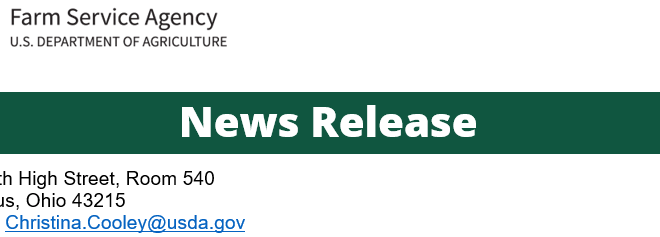– Agricultural producers in Ohio should make an appointment with their local Farm Service Agency (FSA) office to complete crop acreage reports before the applicable deadline after planting is complete.
“Many USDA programs require producers to file an accurate crop acreage report by the applicable deadline in order to receive program benefits,” said Dr. John Patterson, State Executive Director in Ohio. “Once planting is complete, call your local FSA office to make an appointment to report your acreage. We also encourage you to take care of any other FSA-related business during your appointment.”
An acreage report documents a crop grown on a farm or ranch, its intended use and location. Filing an accurate and timely acreage report for all crops and land uses, including failed acreage and prevented planted acreage, can prevent the loss of benefits.
How to File a Report
The following acreage reporting dates are applicable in Ohio:
July 15, 2024 — Report all your Burley Tobacco, Cabbage (Planted 3/19/24-5/31/24), Corn, Grain Sorghum, Hybrid Corn Seed, Spring Oats, Popcorn, Potatoes, Soybeans, Sugar Beets, Tomatoes and all other crops. Report Perennial Forage Crops. Report Conservation Reserve Program (CRP) acreage.
Aug. 15, 2024 — Report Cabbage (Planted 6/1/24-7/20/24).
Sept. 30, 2024 — Report Aquaculture.
Dec. 15, 2024 —- Report Fall-Seeded 2025 crops, Barley, Fall Wheat, and all other Fall-Seeded Small Grains.
To file a crop acreage report, producers need to provide:
- Crop and crop type or variety
- Intended crop use
- Number of crop acres
- Map with approximate crop boundaries
- Planting date(s)
- Planting pattern, when applicable
- Producer shares
- Irrigation practice(s)
- Acreage prevented from planting, when applicable
- Other required information
Acreage Reporting Details
The following exceptions apply to acreage reporting dates:
- If the crop has not been planted by the acreage reporting date, then the acreage must be reported no later than 15 calendar days after planting is completed.
- If a producer acquires additional acreage after the acreage reporting date, then the acreage must be reported no later than 30 calendar days after purchase or acquiring the lease. Appropriate documentation must be provided to the county office.
Noninsured Crop Disaster Assistance Program (NAP) policy holders should note that the acreage reporting date for NAP-covered crops is the earlier of the dates listed above or 15 calendar days before grazing or crop harvesting begins.
Prevented Planted Acreage
Producers should also report crop acreage they intended to plant but were unable to because of a natural disaster, including drought. Prevented planted acreage must be reported on form CCC-576, Notice of Loss, no later than 15 calendar days after the final planting date as established by FSA and USDA’s Risk Management Agency (RMA).
FSA recently updated policy that applies to prevented planted acreage due to drought. To certify prevented planted acreage due to drought, all of the following must apply:
- The area that is prevented from being planted has insufficient soil moisture for seed germination on the final planting date for non-irrigated acreage.
- Prolonged precipitation deficiencies that meet the D3 or D4 drought intensity level as determined by the U.S. Drought Monitor.
- Verifiable information must be collected from sources whose business or purpose is recording weather conditions as determined by FSA.
Continuous Certification Option for Perennial Forage
Agricultural producers with perennial forage crops have the option to report their acreage once, without having to report that acreage in subsequent years, as long as there are no applicable changes on the farm. Interested producers can select the continuous certification option after FSA certifies their acreage report. Examples of perennial forage include mixed forage, birdsfoot trefoil, chicory/radicchio, kochia (prostrata), lespedeza, perennial peanuts and perennial grass varieties.
Once the continuous certification option is selected, the certified acreage will roll forward annually with no additional action required by the producer in subsequent years unless the acreage report changes.
Farmers.gov Portal
Producers can access their FSA farm records, maps, and common land units through the farmers.gov customer portal. The portal allows producers to export field boundaries as shapefiles and import and view other shapefiles, such as precision agriculture boundaries within farm records mapping. Producers can view, print and label their maps for acreage reporting purposes. Level 2 eAuthentication or login.gov access that is linked to a USDA Business Partner customer record is required to use the portal.
Producers can visit farmers.gov/account to learn more about creating an account. Producers who have authority to act on behalf of another customer as a grantee via an FSA-211 Power of Attorney form, Business Partner Signature Authority or as a member of a business can now access information for the business in the farmers.gov portal.
For questions, producers should contact their FSA county office.
 WQIO Ohio's Super Station
WQIO Ohio's Super Station


